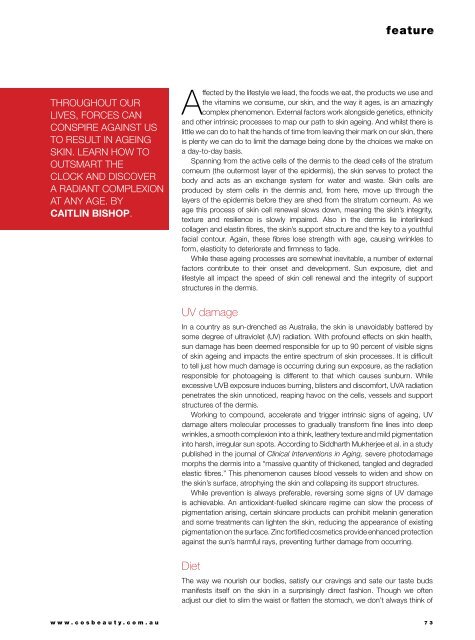Cosmetic Surgery and Beauty Magazine #66
Cosmetic Surgery and Beauty is the must-read for anyone considering a cosmetic procedure or treatment. With hundreds of before and after photo, and cosmetic and plastic surgery experts featured, tis educational resource will allow you to confidently decide the best course of action. This issue includes features on: Breast reshaping Six ways to get younger looking skin Surgical vs non-surgical fat reduction Body soothing products Energy boosters DIY perfect makeup As well as regular features on breast augmentation, facelifting, rhinoplasty and liposculpture/liposuction.
Cosmetic Surgery and Beauty is the must-read for anyone considering a cosmetic procedure or treatment. With hundreds of before and after photo, and cosmetic and plastic surgery experts featured, tis educational resource will allow you to confidently decide the best course of action.
This issue includes features on:
Breast reshaping
Six ways to get younger looking skin
Surgical vs non-surgical fat reduction
Body soothing products
Energy boosters
DIY perfect makeup
As well as regular features on breast augmentation, facelifting, rhinoplasty and liposculpture/liposuction.
You also want an ePaper? Increase the reach of your titles
YUMPU automatically turns print PDFs into web optimized ePapers that Google loves.
feature<br />
Throughout our<br />
lives, forces can<br />
conspire against us<br />
to result in ageing<br />
skin. Learn how to<br />
outsmart the<br />
clock <strong>and</strong> discover<br />
a radiant complexion<br />
at any age. By<br />
Caitlin Bishop.<br />
Affected by the lifestyle we lead, the foods we eat, the products we use <strong>and</strong><br />
the vitamins we consume, our skin, <strong>and</strong> the way it ages, is an amazingly<br />
complex phenomenon. External factors work alongside genetics, ethnicity<br />
<strong>and</strong> other intrinsic processes to map our path to skin ageing. And whilst there is<br />
little we can do to halt the h<strong>and</strong>s of time from leaving their mark on our skin, there<br />
is plenty we can do to limit the damage being done by the choices we make on<br />
a day-to-day basis.<br />
Spanning from the active cells of the dermis to the dead cells of the stratum<br />
corneum (the outermost layer of the epidermis), the skin serves to protect the<br />
body <strong>and</strong> acts as an exchange system for water <strong>and</strong> waste. Skin cells are<br />
produced by stem cells in the dermis <strong>and</strong>, from here, move up through the<br />
layers of the epidermis before they are shed from the stratum corneum. As we<br />
age this process of skin cell renewal slows down, meaning the skin’s integrity,<br />
texture <strong>and</strong> resilience is slowly impaired. Also in the dermis lie interlinked<br />
collagen <strong>and</strong> elastin fibres, the skin’s support structure <strong>and</strong> the key to a youthful<br />
facial contour. Again, these fibres lose strength with age, causing wrinkles to<br />
form, elasticity to deteriorate <strong>and</strong> firmness to fade.<br />
While these ageing processes are somewhat inevitable, a number of external<br />
factors contribute to their onset <strong>and</strong> development. Sun exposure, diet <strong>and</strong><br />
lifestyle all impact the speed of skin cell renewal <strong>and</strong> the integrity of support<br />
structures in the dermis.<br />
UV damage<br />
In a country as sun-drenched as Australia, the skin is unavoidably battered by<br />
some degree of ultraviolet (UV) radiation. With profound effects on skin health,<br />
sun damage has been deemed responsible for up to 90 percent of visible signs<br />
of skin ageing <strong>and</strong> impacts the entire spectrum of skin processes. It is difficult<br />
to tell just how much damage is occurring during sun exposure, as the radiation<br />
responsible for photoageing is different to that which causes sunburn. While<br />
excessive UVB exposure induces burning, blisters <strong>and</strong> discomfort, uva radiation<br />
penetrates the skin unnoticed, reaping havoc on the cells, vessels <strong>and</strong> support<br />
structures of the dermis.<br />
Working to compound, accelerate <strong>and</strong> trigger intrinsic signs of ageing, UV<br />
damage alters molecular processes to gradually transform fine lines into deep<br />
wrinkles, a smooth complexion into a think, leathery texture <strong>and</strong> mild pigmentation<br />
into harsh, irregular sun spots. According to Siddharth Mukherjee et al. in a study<br />
published in the journal of Clinical Interventions in Aging, severe photodamage<br />
morphs the dermis into a “massive quantity of thickened, tangled <strong>and</strong> degraded<br />
elastic fibres.” This phenomenon causes blood vessels to widen <strong>and</strong> show on<br />
the skin’s surface, atrophying the skin <strong>and</strong> collapsing its support structures.<br />
While prevention is always preferable, reversing some signs of UV damage<br />
is achievable. An antioxidant-fuelled skincare regime can slow the process of<br />
pigmentation arising, certain skincare products can prohibit melanin generation<br />
<strong>and</strong> some treatments can lighten the skin, reducing the appearance of existing<br />
pigmentation on the surface. Zinc fortified cosmetics provide enhanced protection<br />
against the sun’s harmful rays, preventing further damage from occurring.<br />
Diet<br />
The way we nourish our bodies, satisfy our cravings <strong>and</strong> sate our taste buds<br />
manifests itself on the skin in a surprisingly direct fashion. Though we often<br />
adjust our diet to slim the waist or flatten the stomach, we don’t always think of<br />
www.cosbeauty.com.au 73

















